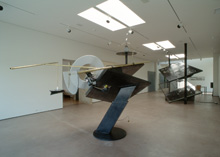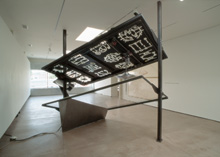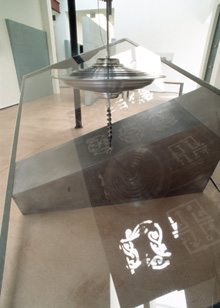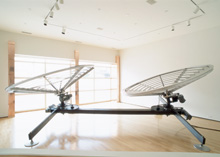 |
   |
Alice Aycock Alice Aycock has realized that the strongest possibilities are found in that moment of transition from one state of being to another, when even an emergent nightmare could just as easily lapse into absurdity. Her sculptures evoke a laugh, not for their humor, but for the nervous anxiety of trying to place them within the consciousness. An Alice Aycock sculpture or the grand drawings that are corollaries to the sculpture, as much as they are plans, shuttle focus between the realms of the physical, the intellectual, and the emotional. They are hysterical. They walk a tightrope. Sculpture has always functioned as a between state, intermediaries between a people and their gods or history. Aycock, however, must work in a world when gods are dead and even history is relative. Her response is to go with this challenge, to play at the edges to overload the intellectual structure through piling up more and more associations until breakdown threatens. Aycock's works recall the first pleasures of learning. They contain the excitement of that first moment when the patterns on the page began to yield up words and the words images. Later, there is the excitement of leafing through encyclopedias, dictionaries, discovering the joys of a world beyond immediate experience. Then there is the desultory pleasure of reading a text in a furnished library and being bidden to their books by the floating numbers of annotations. The tempting generosity of such references is the basis of a personalized, democratic self-education. They lead us not only through the text but to other texts, other times and thinkers, sometimes sighted through the openings of the text, sometimes mirroring. They invite the reader to associate, to participate in the exciting deferral of climax. Two decades ago, Aycock recognized this experience as fundamental to her work: " In my work as a whole, structure consists of a set of directions for a performance; that is structure is structuring." Let us append a series of annotations to four recent sculptures. In The Key of Years, Aycock gathers together the range of words in English which reads both in text and in reflection. In doing so, she creates a class of wordplay that has not existed previously. Its principles are simple: the words must be formed by symmetrical letters ( thus M but not N. A,I,O, or U but not E). The idea grows out of contemplation of alchemical arcana, systems such as the Magic Square. S A T O R This translates roughly, " the creator, all knowing, maintains his creations in the vortex." Such phenomena merely exist. Their places within the systems of knowledge ( arithmetic, linguistics) are unassailable, yet they refer only to themselves; they are a closed system. In The Key of Years, this idea is paired with bellows which mechanically blow some air into this closed system and reference human lungs and thus speech. East River Roundabout , a permanently sited work which opened in September 1995 is her most gestural work to date. Her inspiration was the particle diagrams of quantum physics and Fred Astaire's elegant dancing up the walls/ across the ceiling. Within an overhead cylindrical coil based on amusement park loop-de-loops and children's modular toys, Aycock has placed stairs. Now enclosed and resting on their sides, the stairs are of use only as symbols, provocations to dream, Their continuity of the language and shamanistic visions, travels between the mundane and the world of sprits intact. The encircling loop is more modern in its associations. Its structural elements reveal its fairground origins. Visitors crane their heads to look through this piece at the dancing sky above or try to focus through its ends to frame skyscrapers on one side of the Queensborough Bridge or the other. The sculpture's insouciance marks, focuses, enhances the infinity of the sky and the activity of the city, to create visual synergy that buoys the observer's spirits. Whirlpools employs a device similar to the mirror in The Key of Years, to spin the two spirals. It is the motor mechanism for an amusement ride called the Trabant. Another reference to the artist is Leonardo's Deluge Series, which inspired the artist's earlier work, The Leonardo Swirl. In addition there are Durer's catastrophic dream of a waterspout, Michelangelo's God separating the heavens and the earth, Blake's voice from within the whirlwind (Job) and the work Aycock first presented to the public in 1971, Sand / Fans, in which four industrial fans blew a pile of sand until it was level- a demonstration of entropy. As the forms spin, there is an invocation of Ezekiel (1:4-14) transgressing divisions between the sacred and the secular. The fascination with the language is again invoked; just what were the words the artist muses, which God spoke in that fundamental act of creation-bringing the world into being? The substratum of mythology, here Western religion, which seeks to organize a cultures knowledge to allay its anxieties, attracts Aycock. Can time only go one way? Cosmologists today entertain ideas that only a decade ago would have been heresy. At least one more level of reference must be considered for Whirlpools, that is to the artist's past works, both the " blade machines" whose mesmerizing whirling mixed with extreme physical threat to charge the galleries and museums in which they were viewed with an emotional power that remains in the memories of all those who saw the works, and the spinning tops of, The Game of Dreidles or Greased Lightning, whose roots were based in popular folk cultures. Each of these references exists just slightly below the level of cognition, as do the multiple layers of Waltzing Matilda. As with Whirlpools the title is unusually direct for Aycock; in the past, the "literary" quality of certain titles and and the scientific pretensions of others have created intellectual spaces that often obscured the specific appearance of the works. Memory serves up the traditional Australian tune, Waltzing Matilda, but even that collapses. It wasn't traditional at all, but made it's copywrittten emergence in the early years of the century. Still Aycock's is not that woozy melody, but Tom Waites' piano bar dirge. It shouldn't surprise that it's not the steps of the waltz that the top traces. That dance's partnering, isolation in intimacy, occasionally produced scandals during it's 18th-19th c. dissemination. These patterns are of contredances related to the minuet, the court dance of Louis XIV, the symmetries of whose reign are frequently cited in Aycock's garden diagrams. The minuet, in distinction to the waltz, was performed by open couples, the occasional bob of whose gracefully precise glides and steps counterpoint equally structured conversation. The dance faded into the movements of Mozart symphonies. The pattern of the movements here are determined by the outlines of the upper style sheet, which convert dance step charts from an eighteenth century German dictionary into glyphs that could as well be Zen calligraphs. The openings in this pattern allow a spinning top to move in rough approximation to the diagrams. This top attempts to transfer by etching or scratching onto the glass plate the patterns above. It is a "skating on thin ice" that expresses the futility of trying to transfer a moment in time from one state to another. Each scribble marks the impotence of such an aspiration doomed to failure. As in the other works in this exhibition, we are brought within range of form or language, but never enter. Monroe Denton
|




